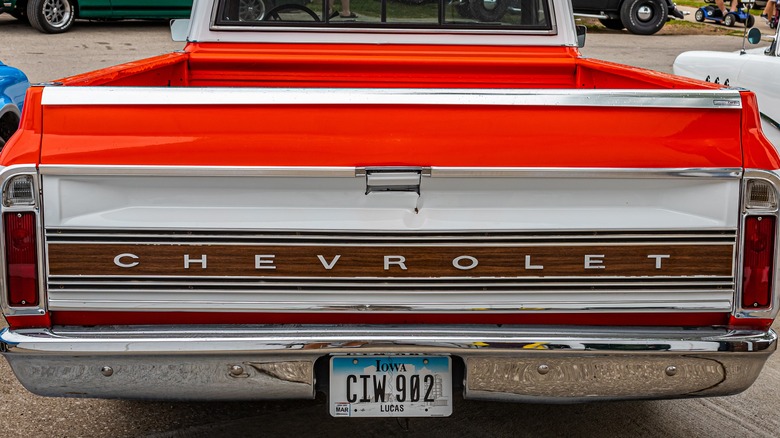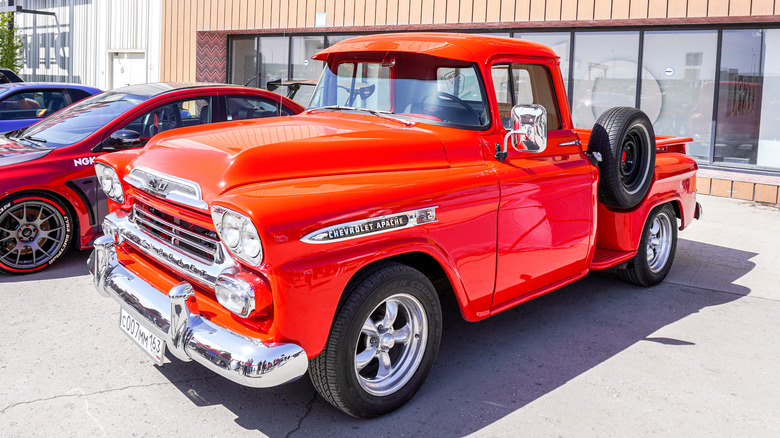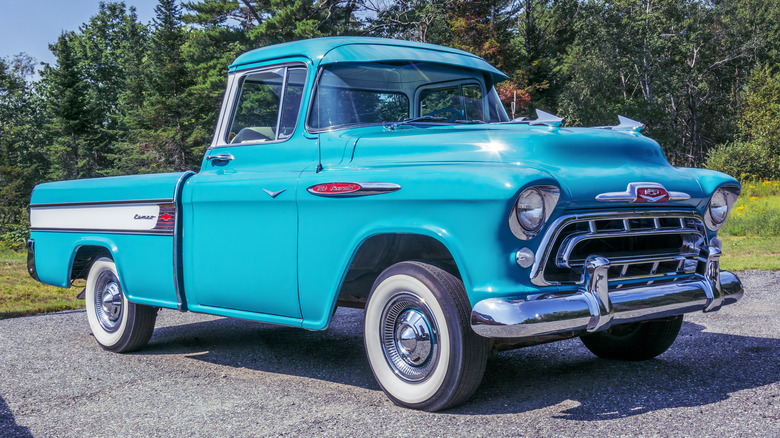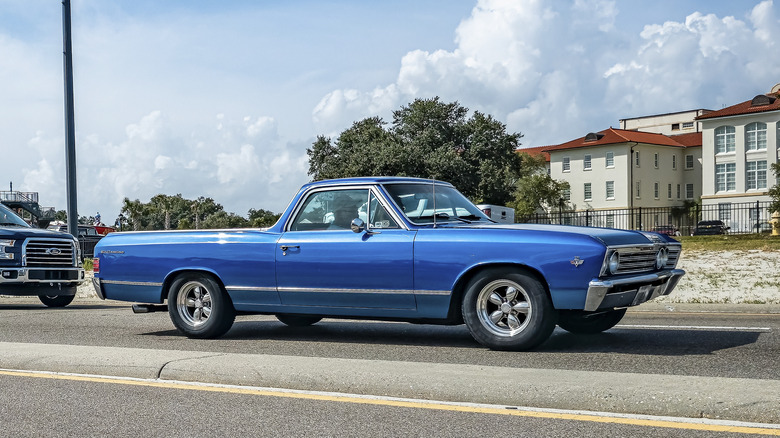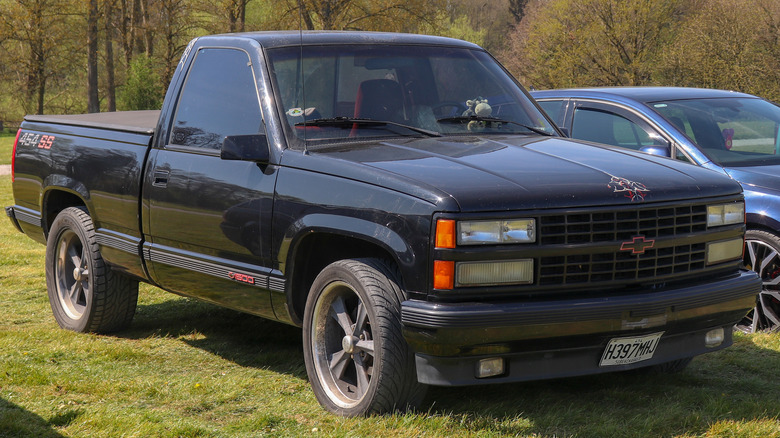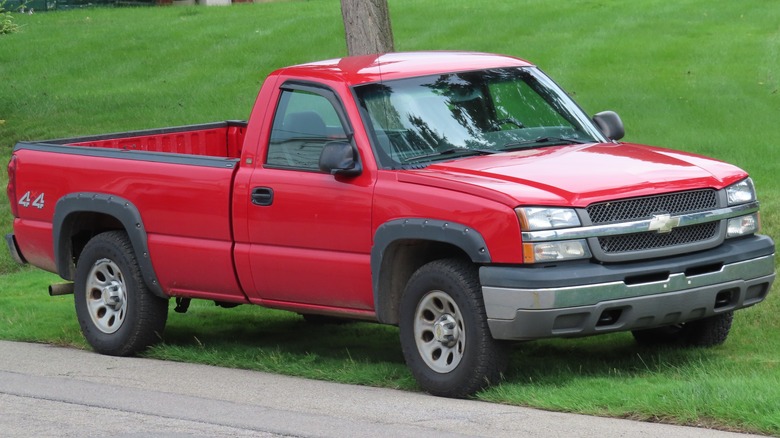The 5 Most Impressive Chevy Trucks Of All Time
Chevrolet is one of the most enduring automotive brands in the United States, which is kind of ironic since the name came from a Swiss race car driver named Louis Chevrolet. While Chevy is a subsidiary of General Motors — and has been since GM acquired it all the way back in 1918 — you'd be forgiven for assuming it was its own thing. After all, Chevy is one of the biggest players in the global automotive scene, having sold millions of cars and trucks over the years.
Speaking of trucks, while Chevy has no shortage of excellent cars to its name, the brand's many pickup trucks constitute some of its biggest claims to fame. Thanks to Chevy's many innovations in the sphere, a pickup truck has become a truly multi-purpose vehicle, something you can use both to handle your physical labor and just take for a casual drive. Chevrolet helped make pickups popular in the U.S., and that's an effort that's been ongoing for generations.
Just about all of Chevy's trucks are worth admiring, but we can think of at least five that deserve special praise.
Chevrolet Task Force
Prior to the 1950s, Chevrolet came to the understanding that nobody owned a pickup truck for fun. If you weren't a farmer, a day laborer, a soldier, or some other form of physical worker, then there wasn't really any reason to drive a pickup truck, much less own one. That changed in 1955 with the release of the Chevy Task Force; a truck that could be everything it needed to be for both the strapping professional and the modern family.
The Task Force was a revolutionary fusion of pickup truck and luxury vehicle, not skimping on either power or amenities. The Task Force had a few different power options available, but the most popular was Chevy's new Taskmaster V8 — a 265 cubic-inch engine boasting a healthy 145 horsepower and 238 pound-feet of torque. This was more than enough to handle most kinds of simple hauling jobs, whether in the bed of the truck or via a tow.
In addition to muscle, though, the Task Force had nifty comfort features like the proprietary "Airmatic" seating. This technology allowed the driver and passenger to tailor the firmness of their seats via built-in air pumps, and a convenient safety step to aid the driver and passenger into the cab.
Chevrolet Cameo Carrier
While the Chevy Task Force was bringing the concept of pickup trucks closer to the average driver, the designers at General Motors were looking to give the vehicles a little extra iconic styling. One such designer was Chuck Jordan, the man who would one day go on to become GM's chief designer. When he was a fresh face at the company in the mid-1950s, Jordan wanted to create a vehicle that would make onlookers say "wow." It was this precise feeling that led to an offshoot of the Task Force, named the Cameo Carrier.
Using a combination of steel and fiberglass, the Cameo Carrier featured a sleek forward profile that wouldn't look amiss on a pricey sports car, combined with a shiny fleetside bed. If you saw this vehicle backing out of a garage, you'd think it was an ordinary pickup, only to be jolted when the front half came into view. The inside of the cabin was also quite snazzy, featuring a wrap-around windscreen, two-toned paint, and even a carpeted floor. Drivers could even opt for an automatic transmission with the 265 V8 engine for that extra bit of sophistication.
Chevrolet El Camino
By the end of the 1950s, Chevy had proven fairly definitively that it had its finger on the pulse of pickup truck styling, but competition was still fierce from other automotive players like Ford. This may be why, in 1959, Chevy decided to invert its thinking a bit for a new innovation. Rather than trucks that were closer to cars, the brand attempted to make a car that was closer to a truck. Thus, the mysterious and iconic Chevrolet El Camino was born.
The original experimental run of the El Camino only lasted one year from 1959 to 1960, but a few years later in 1964, the vehicle really hit its stride — starting a production run that would last for over 20 years. The most distinctive feature of the El Camino is, of course, its bed, swooping out from the back of a body that would normally belong on a traditional sedan. The first two generations of El Camino were marketed as utility vehicles, but with the third generation in 1968, it became more of a sports car, packing a powerful V8 engine.
While the El Camino wasn't quite robust enough to pull the same kind of labor as a full pickup, the mere addition of a bed to a sedan-sized car gave it some extra utility. It was basically a hot rod that you could also use to help your friend move out of an apartment.
Chevrolet 454 SS
In the 1990s, Chevy was focusing its efforts on more muscular pickup trucks, striving to build the perfect utility vehicle. The ultimate goal was fusion between performance and ruggedness, something that could both open up on the highways and charge through muddy, uneven terrain. In 1990, the fruit of that pursuit was the newest successor to the Chevy C/K series, the 454 Super Sport, or "SS" for short.
This beast of a vehicle was intended to be a high-performance spinoff of the main C/K line, equipped with a gigantic 454 cubic-inch V8 engine, capable of 230 horsepower and 385 pound-feet of torque with a three-speed transmission. For the sport-minded, you could also opt for enhancements like Bilstein shocks and a high-performance suspension. All of this could be enjoyed from a stylish velvety red interior, serving as a splash of color against the solid black stock paint job.
While the SS wasn't groundbreaking in itself, it did set an interesting new precedent for both Chevy and the automotive industry as a whole: factory-made sport pickups. By transplanting some of its more powerful engines from heavier trucks into a smaller, sportier package, Chevy could create something that a speed-fiend would really be interested in — while still remaining somewhat practical.
Chevrolet Silverado
At the turn of the 21st century, Chevy was looking to put everything it had created in the decades prior to work in creating the ultimate pickup, something with the muscle to haul, the space to carry the family, and the constitution to withstand the elements. The result would be one of Chevy's most enduring vehicles: The Silverado, which remains a mainstay of the brand to this day.
Interestingly, the name "Silverado" had actually been around since the 1970s, though back then, it was just a trim variation for the C/K line. In 1999, it spun off into its own truck as the Silverado 1500. The original Silverado generation, retroactively deemed the "Classic," came with a slew of potential packages, including various cab sizes and entrance doors, bed lengths, and engine sizes. It was the truck that could be anything you needed it to be — and even more so following the release of the heavy-duty Silverado in 2000, and the high-performance Silverado SS in 2003.
In 2024, the Silverado name serves as the base for Chevy's very first wholly-electric pickup, proving that the line serves as a testbed for its newest and best developments alongside its heritage.
